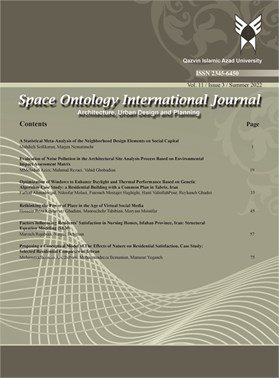Improving the energy efficiency of existing residential buildings by applying passive and cost-effective solutions in the Hot and humid region of Iran
الموضوعات :
Space Ontology International Journal
Amin Mohammadi
1
 ,
Joseph Daraio
2
,
Joseph Daraio
2

1 - Department of Architectural Engineering, Faculty of Art and Architecture, Persian Gulf University, Bushehr, Iran. 7516913817
2 - Faculty of Engineering and Applied Science, Memorial University of Newfoundland (MUN), St. John‘s, NL, Canada.
تاريخ الإرسال : 24 الأربعاء , ذو القعدة, 1441
تاريخ التأكيد : 18 الثلاثاء , رجب, 1442
تاريخ الإصدار : 16 الثلاثاء , ربيع الثاني, 1442
الکلمات المفتاحية:
Energy efficiency,
hot and humid climate,
Cost-Effectiveness,
Energy simulation,
passive Solutions,
ملخص المقالة :
This paper aims to investigate the improvement of the energy efficiency of typical apartment buildings in the hot and humid region of Iran by applying passive and cost-effective solutions. For this purpose, a residential building, that reflects the current typology, is selected in Bushehr, Iran, and its annual energy consumption is explored using electric and gas bills. Then, a primary and calibrated model of the building is made using a real occupancy schedule and hourly weather data of Bushehr in Design Builder Software to simulate its energy performance. Considering the architectural design of the baseline model and using passive solutions (including low-E glazing, thermal insulation of external walls, roof and ceilings, and pre-heating of domestic hot water), a developed model is made. The simulation results indicate that the annual carbon dioxide emission and energy consumption of the developed model is reduced by 18.7% and 20%, respectively. These passive solutions can be used to improve the energy efficiency of existing buildings to achieve low Carbon buildings and neighborhoods in this part of Iran. This study also proposed a new reference for the annual energy consumption of low-energy houses in the hot and humid area of Iran and the Persian Gulf region (75-76 kWh/m2/Year). Moreover, the economic analysis in this study demonstrates that the above-mentioned passive solutions will be cost-effective if the government subsidies for the residential buildings’ energy use are eliminated in this region.
المصادر:
Abazari, T., & Mahdavinejad, M. (2017). Integrated Model for Shading and Airflow Window in BSk. Energy Procedia, 122, 571-576. doi:https://doi.org/10.1016/j.egypro.2017.07.423
Aghamolaei, R. (2019). Evaluation of Supply and Demand in Building Energy Performance: Application of Retrofit Scenarios in Residential Building. Energy Engineering, 116(1), 60-79. doi:10.1080/01998595.2019.12043339
Albatayneh, A., Alterman, D., Page, A., & Moghtaderi, B. (2018). The Impact of the Thermal Comfort Models on the Prediction of Building Energy Consumption. Sustainability, 10(10). doi:10.3390/su10103609
Aldossary, N., Rezgui, Y., & Kwan, A. (2017). Establishing domestic low energy consumption reference levels for Saudi Arabia and the Wider Middle Eastern Region. Sustainable Cities and Society, 28, 265-276. doi:10.1016/j.scs.2016.09.015
Alvand, M., Gholami, Z., Ferrara, M., & Fabrizio, E. (2017). Assessment of Cost Optimal Solutions for High Performance Multi-family Buildings in Iran. Energy Procedia, 111, 318-327. doi:https://doi.org/10.1016/j.egypro.2017.03.102
Ameer, B., & Krarti, M. (2016). Impact of subsidization on high energy performance designs for Kuwaiti residential buildings. Energy and Buildings, 116, 249-262. doi:10.1016/j.enbuild.2016.01.018
ASHRAE. (2009). Fundamentals; American society of Heating, Refrigerating and Air-Conditioning Engineers. In. Atlanta, USA: ASHRAE.
Balali, A., Hakimelahi, A., & Valipour, A. (2020). Identification and prioritization of passive energy consumption optimization measures in the building industry: An Iranian case study. Journal of Building Engineering, 30, 101239. doi:https://doi.org/10.1016/j.jobe.2020.101239
Brahmand Zadeh, D. R. G., Z. (2014). Investigating the trend of changes in power consumption in different sectors during the period from 2001 to 2012. Srtc-amar, 2, 29-33 (In persian).
Burgett, J., Chini, A., & Oppenheim, P. (2013). Specifying residential retrofit packages for 30 % reductions in energy consumption in hot–humid climate zones. Energy Efficiency, 6(3), 523-543. doi:10.1007/s12053-012-9190-6
Chartered Institution of Building Services, E. (2006). Environmental design : CIBSE guide A. London: CIBSE.
Chuan-Rui, Y., Han-Sen, G., Qian-Cheng, W., & Rui-Dong, C. (2020). Revealing the Impacts of Passive Cooling Techniques on Building Energy Performance: A Residential Case in Hong Kong. Applied Sciences, 10(12), 4188. doi:http://dx.doi.org/10.3390/app10124188
EIA. (2016). International Energy Outlook 2016. U.S. Energy Information Administration.
Expert Working Groupe and Editor, E. (2019). Price List for Buildings. (97/747815). Tehran: Planning and Budget Organization of Iran (In Persian).
Haase, M., & Amato, A. (2009). An investigation of the potential for natural ventilation and building orientation to achieve thermal comfort in warm and humid climates. Solar Energy, 83(3), 389-399. doi:10.1016/j.solener.2008.08.015
Jorissen, F., Himpe, E., Picard, D., Buso, T., Laverge, J., Boydens, W., & Helsen, L. . (2018). hybridGEOTABS project : MPC for controlling the power of the ground by integration. (J. Hogeling, Ed.). Rehva Journal, 55(3), 58–64.
Khodabakhsh, P., Fathi, H., & Mashayekhi, S. (2015). Achieving energy efficiency through designing eco-friendly built environment (Tehran case study). International Journal of Sustainable Building Technology and Urban Development, 6(3), 129-139. doi:10.1080/2093761X.2015.1025449
Kwame, A. B. O., Troy, N. V., & Hamidreza, N. (2020). A Multi-Facet Retrofit Approach to Improve Energy Efficiency of Existing Class of Single-Family Residential Buildings in Hot-Humid Climate Zones. Energies, 13(5). doi:10.3390/en13051178
Mohammadi, A., Saghafi, M., Tahbaz, M., & Nasrollahi, F. (2018). The study of climate-responsive solutions in traditional dwellings of Bushehr City in Southern Iran. Journal of Building Engineering, 16, 169-183. doi:10.1016/j.jobe.2017.12.014
Mohammadi, A., Saghafi, M. R., Tahbaz, M., & Nasrollahi, F. (2017). Effects of Vernacular Climatic Strategies (VCS) on Energy Consumption in Common Residential Buildings in Southern Iran: The Case Study of Bushehr City. Sustainability, 9(11). doi:10.3390/su9111950
Monstvilas, E., Stankevičius, V., Karbauskaitė, J., Burlingis, A., & Banionis, K. (2012). Hourly Calculation Method of Building Energy Demand for Space Heating and Cooling Based on Steady-State Heat Balance Equations. Journal Of Civil Engineering And Management, 18(3), 356-368. doi:10.3846/13923730.2012.689994
National Building Regulatory Office, M. o. R. a. U. D. (2011). National Building Regulations- Topic 19: Energy Saving in Buildings. Tehran: Iranian Development Publication (In Persian).
Nooraei, M., Littlewood, J., & Evans, N. (2013). Passive Cooling Strategies for Multi-storey Residential Buildings in Tehran, Iran and Swansea, UK. Paper presented at the Sustainability in Energy and Buildings, Berlin, Heidelberg.
Pacheco-Torgal, F. (2017). Chapter 1 - Introduction to Cost-Effective Energy-Efficient Building Retrofitting. In F. Pacheco-Torgal, C.-G. Granqvist, B. P. Jelle, G. P. Vanoli, N. Bianco, & J. Kurnitski (Eds.), Cost-Effective Energy Efficient Building Retrofitting (pp. 1-20): Woodhead Publishing.
Rehman, H. (2015). Steady State Experimental Analysis of Various Solar Insulation Materials and Techniques for Buildings in Climatic Condition of Ras Al Khaimah, UAE. Energy Procedia, 75, 1419-1424. doi:10.1016/j.egypro.2015.07.241
Rotimi, A., Bahadori-Jahromi, A., Mylona, A., Godfrey, P., & Cook, D. (2017). Estimation and Validation of Energy Consumption in UK Existing Hotel Building Using Dynamic Simulation Software. Sustainability, 9(8), 1391-undefined. doi:10.3390/su9081391
Sadineni, S. B., Madala, S., & Boehm, R. F. (2011). Passive building energy savings: A review of building envelope components. Renewable and Sustainable Energy Reviews, 15(8), 3617-3631. doi:https://doi.org/10.1016/j.rser.2011.07.014
Sağlam, N., Yılmaz, A. Z., Becchio, C., & Corgnati, S. (2017). A comprehensive cost-optimal approach for energy retrofit of existing multi-family buildings: Application to apartment blocks in Turkey. Energy and Buildings, 150, 224-238. doi:10.1016/j.enbuild.2017.06.026
Silvero, F., Montelpare, S., Rodrigues, F., Spacone, E., & Varum, H. (2018). Energy retrofit solutions for heritage buildings located in hot-humid climates. Procedia Structural Integrity, 11, 52-59. doi:10.1016/j.prostr.2018.11.008
Silvero, F., Rodrigues, F., & Montelpare, S. (2019). A Parametric Study and Performance Evaluation of Energy Retrofit Solutions for Buildings Located in the Hot-Humid Climate of Paraguay—Sensitivity Analysis. Energies, 12(3), 427-undefined. doi:10.3390/en12030427
reference, E. (2007). Heating systems in buildings-Method for calculation of system energy requirements and system efficiencies-Part 3-1 Domestic hot water systems, characterisation of needs (tapping requirements). In CEN/TC 228: Technical Committee CEN/TC 228.
Sun, X., Gou, Z., & Lau, S.-Y. (2018). Cost-effectiveness of active and passive design strategies for existing building retrofits in tropical climate: Case study of a zero energy building. Journal of Cleaner Production, 183, 35-45. doi:10.1016/j.jclepro.2018.02.137
Sun, X., Gou, Z., & Lau, S. S.-Y. (2018). Cost-effectiveness of active and passive design strategies for existing building retrofits in tropical climate: Case study of a zero energy building. Journal of Cleaner Production, 183, 35-45. doi:https://doi.org/10.1016/j.jclepro.2018.02.137
Tahsildoost, M., & Zomorodian, Z. (2020). Energy, carbon, and cost analysis of rural housing retrofit in different climates. Journal of Building Engineering, 30, 101277. doi:https://doi.org/10.1016/j.jobe.2020.101277
Tan, Y., Liu, G., Zhang, Y., Shuai, C., & Shen, G. (2018). Green retrofit of aged residential buildings in Hong Kong: A preliminary study. Building and Environment, 143, 89-98. doi:10.1016/j.buildenv.2018.06.058
Wu, J., Guo, S., Huang, H., Liu, W., & Xiang, Y. (2018). Information and Communications Technologies for Sustainable Development Goals: State-of-the-Art, Needs and Perspectives. IEEE Communications Surveys & Tutorials, 20, 2389-2406. doi:10.1109/COMST.2018.2812301
Wu, J., Rangan, S., & Zhang, H. (2012). Green communications theoretical fundamentals, algorithms and applications. Boca Raton, FL: Boca Raton, FL : CRC Press.
Yudelson, J. (2010). Greening existing buildings: McGraw-Hill New York.
Online References
Brebbia, C. A. B., E. (2011). Sustainable Development and Planning V. Retrieved 8/8/2019 https://www.witpress.com/books/978-1-84564-544-1
DesignBuilderLtd. (2019). EnergyPlus simulation key features. Retrieved 10/11/2019, from DesignBuilder Wesite https://designbuilder.co.uk/simulation
Hourly Weather Data of Bushehr. (2018). Retrieved 8/18/2018, from Islamic Republic of Iran Meteorological Organization (IRIMO)- Meteorological data request system https://data.irimo.ir/
IDA, T. W. B. I. (2019). CO2 Emissions (Metric Tons Per Capita). Retrieved 8/8/2019 https://data.worldbank.org/indicator/EN.ATM.CO2E.PC
MOP. (2018). Electricity Tariffs and their general conditions. Retrieved 9/7/2019, from Ministry of Power- Islamic Rebuplic of Iran http://tariff.moe.gov.ir/
NGC. (2018). Household gas tariffs. Retrieved 9/7/2019, from Tariffs and Contracts Affairs- National Gas company- Islamic Republic of Iran http://mgd.nigc.ir/Portal/Home/
![]() ,
Joseph Daraio
2
,
Joseph Daraio
2
![]()


